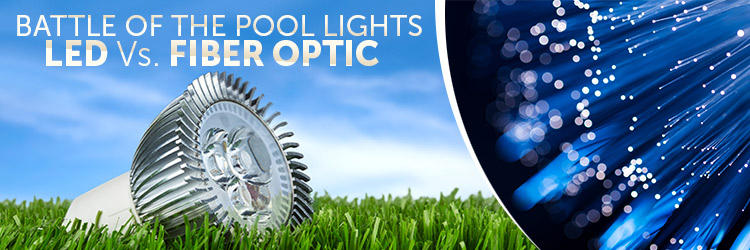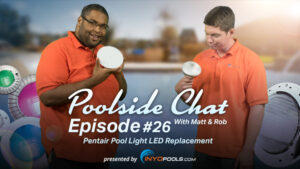Swimming pool lights are typically used for two purposes: traditional, to help see, or simply for aesthetics. Swimming pool lights help illuminate your pool water, creating unique and beautiful effects for your guests and family. They add an additional glow to finish the beauty your pool brings to your home at night
At first, simple white lights were only available. Then, you were able to buy colored lens covers to illuminate certain colors. Now, pool owners can take advantage of colored lights that bring programmable light shows to create different ambiences to fit your mood and special occasion.
For a long time, if you wanted to truly beautify your pool with lights, fiber optic was the sure way to go. In fact, it may have been one of the only ways to go. With the introduction of LED, pool owners have more options to choose from. And with more options, comes more questions and concerns. Not to mention that in ground pool lights are not as flexible as other pool equipment to replace. You definitely want to get it right the first time.
Let’s discuss some of the key benefits and advantages each light has in hopes of saving you precious money and time. Hopefully by the end, you will have made up your mind about which light is best suitable for your swimming pool.
Before we get into the key benefits of each light, let’s discuss how each light works. Both types of light illuminate your swimming pool but in very different ways.

LED
A light-emitting diode (LED) is a two lead semiconductor light source. It has an actual bulb that is submerged into water contained within a niche in your pool wall. The light bulb is sealed to prevent water from getting into it. The cord travels from the bulb to the switch where the light is controlled. Unlike fluorescent light bulbs, the efficiency of LED lighting fixtures aren’t affected by the shape or size of the light housing.
The popularity of LED lights have increased dramatically within the last several years. The growth of LED lights can be attributed to good old Uncle Sam and his want to go green. As you know, incandescent bulbs were phased out and eventually completely replaced by Compact Fluorescent Lights (CFL) and LEDs. This push was to relieve pressure put on the power grid by the inefficient standard bulbs. This changeover created a boom in development to make LED technology stronger, more durable and less expensive. For more information on why LEDs are so popular, please check out our other blog post “Why Are LED Lights So Popular?”
Fiber Optic
Fiber optics function as a ‘light pipe’ to transmit light between two ends of a fiber optic cable. There is a bulb located in a light box (illuminator) that is typically installed somewhere above your pool. The light from the bulb travels through the fiber optic cable to a special fitting within your pool wall. The light is emitted from the end of the cable. Fiber optic cables have the versatility to hang along the perimeter of your pool or underwater.

Round 1: Changing The Bulb
The light bulb within your fixture housing is the part that probably needs changing the most. Bulbs vary in lifespan, typically lasting a few thousand hours. When it comes time to change the bulb, you don’t want something that requires a lot of time or unnecessary energy. Keep in mind, whenever you break a seal or gasket, the manufacturer recommends replacing it as well. Which of the two do you think is easiest to change? LED or Fiber Optic?
LED: Changing the bulb on LED lights can become tricky for one reason: not every LED pool lamp has replaceable bulbs. Popular pool lights such as the Pentair Intellibrite, Hayward Colorlogic, and Jandy Watercolor are great LED lights, however, you cannot replace just the bulb. When your bulb goes out, you will have to replace the entire light. This potentially becomes a very costly replacement.
Still, there are some white pool lamps that are versatile enough to retrofit a colored LED bulb. Both the Hayward Astrolite and the Pentair Amerlite are great lights that have the ability to use both Halogen and LED light bulbs.
There is a large misconception that you need to remove water from your pool in order to change the bulb in your pool light. This is untrue. You can simply remove the entire housing and bring it to the surface. It is estimated to take only about 15-30 min to properly change the bulb. If you need a little direction, we have a tutorial and video showing how to replace a swimming pool or spa light.
 FIBER: Since the bulb is already at surface level, located inside the illuminator, changing the bulb in a Fiber Optic unit is a rather simple and easy job. You’re looking to spend a few hundred dollars to replace the lamp in your illuminator. In comparative costs, it’s like a third, or a fourth, of the cost of a whole illuminator (depending on the one you get).
FIBER: Since the bulb is already at surface level, located inside the illuminator, changing the bulb in a Fiber Optic unit is a rather simple and easy job. You’re looking to spend a few hundred dollars to replace the lamp in your illuminator. In comparative costs, it’s like a third, or a fourth, of the cost of a whole illuminator (depending on the one you get).
Winner: FIBER (1-0)
Round 2: Initial Cost vs. Lifetime Cost
Money can be a strong contributing factor when deciding to make a purchase. Is the product worth the selling price? Will I have to replace parts in a year or two? Or, is spending a lot of money up front a better investment long term? All are valid questions and concerns our customers battle with all the time. Let’s determine which is more cost effective for you.
LED: The average cost of an LED light ranges from $400 to $900, depending on the brand, model, and wattage. The only parts that will need attention are the bulbs and gaskets. Whenever you replace your bulb, the manufacturer will automatically recommend changing out your o-rings and gaskets to prevent water damage. Each light should last a few pool seasons, making the initial price of the light worth every penny in the long run.
FIBER: A fiber optic light unit average cost is between $900 and $1500. Immediately, the initial price of a fiber optic light is much more than an LED. In a fiber optic system, a fan is needed to cool the bulb. There is a small electric motor that rotates the color wheel causing the light to change. Over time these parts can fail. Between your cooling fan, color wheel motor, and control board, you’re looking at more than a few hundred dollars in replacement parts. In the long run, you will spend more money in repairs for a fiber optic unit than a LED.
Winner: LED (1-1)
Round 3: Brightness
Ultimately how bright you want your pool is completely up to you as a pool owner. Some pools are located directly next to or behind a window leading into a sleep area. If that’s the case, you may not want a super bright light. However, other pools are blocked by trees and bushes and therefore need as much light as possible.
Are you in need of more or less light?
 LED: One full sized LED pool lights should illuminate an average sized pool with no problem. In fact, LEDs are known for their brightness. Smaller LED lights, like the Fiberstars PAL- Treo or the Savi Melody, might require two lights on pools bigger than 15 x 34. Pools with multiple lights are usually installed on opposite ends of the pool for an equal effect.
LED: One full sized LED pool lights should illuminate an average sized pool with no problem. In fact, LEDs are known for their brightness. Smaller LED lights, like the Fiberstars PAL- Treo or the Savi Melody, might require two lights on pools bigger than 15 x 34. Pools with multiple lights are usually installed on opposite ends of the pool for an equal effect.
One of the brightest lights we carry (and on the market today) is the Pentair Intellibrite 5g pool light. It comes in both white and colored lens. With its custom reflector and unique lens design, the IntelliBrite 5g is the brightest and most efficient underwater LED light available
FIBER: In theory, fiber optic lights work perfectly. However, if you’re trying to fully illuminate your entire pool, fiber optic lights might not be the way to go. Honestly, they are best used for the ambiance. Their subtle and subdued color makes for great parties and setting the right mood
Winner: LED (2-1)
Round 4: Safety
Let’s be honest, water and electricity do not mix. If it isn’t already, safety should always be one of your first concerns when deciding on a purchase for your family. Are there any safety concerns that you should be aware of? Let’s find out.
LED: Despite what people usually think, LED lights are extremely safe. Most are made with low voltage. There is a transformer that converts to 12V, which is roughly the same as a car charger.
FIBER: In fiber optic lights, at no point does electricity come close to the water. All of it is located in the illuminator, which is installed away from your pool.
Winner: FIBER (2-2)
Final Round: Size and Location
If you inherited your pool with the purchase of your home, you may not have a lot of wiggle room when it comes to the location of your pool equipment. With the exception of making modifications to your pool, there may be very little you can do but stay within the parameters set forth by the builder. Before you replace your light, do you have room for the light you’re buying?
LED: The major components of a LED light include the light and transformer located at the pool equipment. A light controller can be purchased separately and installed to control the light remotely. LED lights also come in various cord lengths, allowing pool owners more freedom to install their lights in different locations around their pool. When in doubt, always go larger!
FIBER: The most crucial piece of equipment in a fiber optic light system is the illuminator. Fiber optic cable must return back to the illuminator, where the light source originates. Typically, the illuminator must be within 10’-12’ of the pool, unless the fiber optic is custom made. This presents a problem for pool owners if they wanted to place the light at the end of the pool with a significant amount of space.
And the overall winner is…..
After tallying the scores, it’s apparent that LED lights have come into the pool game and made their mark. In comparison to Fiber Optic lights, LED lights are more cost efficient – both initially and long term. The absence of an illuminator means the light is much brighter and direct. And although fiber optic units are great lights, if the reason you purchased a pool light is to see, then you should stick with the LED.
However, if you already have enough light to see and want to simply add a serene green light to your pool, fiber optic units may be the best choice for you. They are very sleek and can easily be added to beautify your backyard.
At the end of the day, both LED and fiber optic lights will get the job done. You simply have to determine which job you’re trying to accomplish first.













Leave a Reply